We may be compensated if you purchase through links on our website. Our team is committed to delivering honest, objective, and independent reviews on home products and services.
Composite decking is durable and low-maintenance, making it a great addition to your yard. This modern alternative to traditional wood decking offers long-lasting beauty without the need for regular staining or sealing. In the video above, This Old House expert Tom Silva demonstrates the step-by-step process of installing composite decking.
What Is Composite Decking?
Composite decking is an engineered product made from a mixture of wood fibers and recycled plastic. This combination results in a material that looks like wood but with better durability and resistance to weathering, rot, and insect damage.
Benefits of Composite Decking
Composite decking offers several advantages over traditional wood decking:
- Durability: Composite is resistant to rot, warping, and insect damage.
- Easy to clean: Unlike traditional wood, which may require specific cleaners and power washing, you can clean composite decking easily with just soap and water.
- Eco-friendly: Composite is often made from recycled materials.
- Long lifespan: It can last 25–30 years with proper care.
- Low maintenance: No need for regular staining, sealing, or painting.
- Splinter-free: The smooth surface is comfortable for bare feet.
Preparing for Installation
Proper preparation is crucial for a successful installation. First, gather the necessary tools and materials:
- 2×4 for tapping block
- Chalk line
- Circular saw
- Composite decking boards
- Composite decking screws
- Drill/driver
- End nippers
- Framing square
- Hammer
- Hidden fasteners
- Jigsaw
- Putty knife
- Sledgehammer
- Tape measure
Before installing the composite decking, make sure your deck frame is level, structurally sound, and meets local building codes. Address signs of weakness or damage in the substructure to avoid complications during the installation.
Substructure Inspection
Thoroughly inspect your deck substructure to confirm it can support composite decking. Look for signs of rot, insect damage, or warping in the joists and beams. Replace any damaged parts. Make sure that joist spacing complies with the manufacturer’s recommendations for composite decking, usually 16 inches on-center for straight decking.
Installing the First Composite Deck Board
The first deck board sets the foundation for the entire installation. Getting this step right ensures a straight and properly aligned deck.
Measuring and Cutting
Composite decking can be more challenging to cut than traditional wood because of its density. Make sure your tools are sharp, and focus on precision when cutting:
- Measure the deck’s length where you plan to install the first board.
- Cut the composite decking board to length using a circular or power miter saw.
- Use a jigsaw to cut notches or holes for obstacles such as downspouts if necessary.
Positioning and Securing
Aligning the first board properly helps subsequent boards follow the correct path. Double-check measurements and alignment before securing the board in place:
- Place the cut board along the edge of the deck closest to the house.
- Use a putty knife to slip the board under any existing metal flashing, as Silva demonstrates in the video.
- Measure to ensure the first deck board is parallel with the deck’s outer edge.
- Secure the board with composite decking screws along the edge closest to the house, driving one screw into each joist.
Using Hidden Fasteners to Install a Composite Deck
Hidden fasteners are key to achieving a clean, seamless look. They secure the boards while remaining out of sight, creating a smooth surface free of visible screw heads.
Installing Hidden Fasteners
Once you have the first board installed, you can use hidden fasteners to install subsequent boards:
- Place a hidden fastener at each joist along the edge of the installed deck board.
- Use a plastic tapping block and hammer to drive the fastener’s sharpened spikes into the board’s edge.
- Use a drill/driver to secure each hidden fastener to the joist, screwing it at a 45-degree angle as shown in the video.
Attaching Subsequent Boards
Now you can attach additional decking boards:
- Cut the next decking board to length and position it against the first board’s hidden fasteners.
- Use a 2×4 tapping block and sledgehammer to drive the board onto the hidden fasteners’ protruding spikes.
- Stand on the board while tapping to keep it flush against the deck structure.
- Repeat the process of installing hidden fasteners and attaching boards across the deck.
Make sure each board is tightly secured before moving on to the next.
Fastening Tips
Follow our tips for even and secure fastening:
- Double-check the fit and alignment of each board before permanently affixing the fasteners.
- Keep a spare tapping block handy. The block may wear out or become less effective due to the force applied by the sledgehammer.
- Use a chalk line to guide the placement of your boards and fasteners. This can help maintain straight lines and even gaps.
Navigating Decking Obstacles and Edges
During your installation, you’ll encounter obstacles such as railing posts and the deck’s outer edges. These areas require special attention and techniques for a polished finish.
Working Around Posts
- Use a framing square to mark the location of each post on the decking boards.
- Measure the distance from the deck’s edge to the post and transfer this measurement to the board.
- Cut notches in the boards using a jigsaw to fit around the posts, allowing for a small gap for expansion.
Silva cuts his notches slightly smaller than his measurements to ensure a tight fit.
Installing the Final Boards
For the last few boards, you may need to modify your approach slightly. Use end nippers to remove the spikes from one side of the hidden fasteners if necessary, then drop the final board into place and secure it with composite decking screws.
Composite Decking Finishing Touches
The final steps involve trimming the deck boards to length and completing a final inspection and cleanup.
Trimming Excess Length
Here’s how to get a smooth, even edge when trimming excess decking:
- Snap a chalk line across the ends of the deck boards to mark the desired length.
- Secure a straight-edged board along the chalk line to serve as a saw guide.
- Use a circular saw to trim the deck boards to length, following the straight-edge guide for a clean cut.
Final Inspection and Cleanup
A thorough inspection helps ensure everything is in place and the deck is ready for use:
- Check all boards for secure attachment and proper spacing.
- Remove any debris or sawdust from the deck surface.
- Inspect the edges and corners for any rough spots that may need sanding.
Our Conclusion
While it requires attention to detail and some DIY skills, the long-lasting, low-maintenance benefits of composite decking make it a worthwhile investment for many homeowners. Couple that with the easy cleaning process and eco-friendly nature of many composite decking options, and you have a practical, appealing addition to your outdoor space.
Keep in mind that while the initial cost of composite decking may be higher than traditional wood, the reduced maintenance costs and increased lifespan can offer considerable savings over time.










